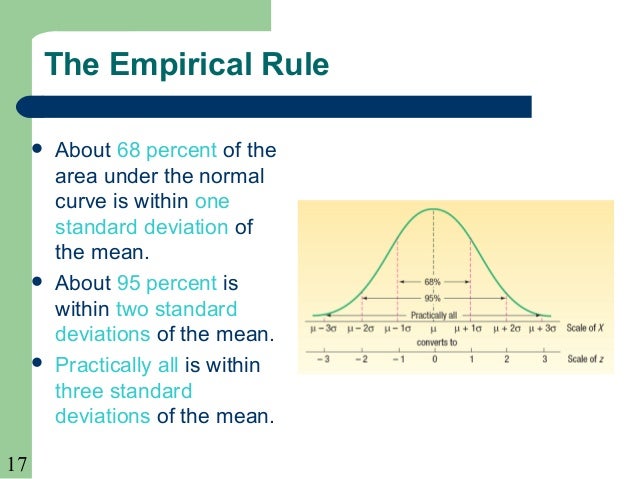

Thus statement (6) must definitely be correct. The empirical rule states that almost all the data in a normal distribution falls within three standard deviations of the mean. The rule states that (approximately): - 68 of the data points will fall within one standard deviation of the mean. Under this rule, 68 of the data falls within one standard deviation, 95 percent within two standard deviations, and 99.7 within three standard deviations from the mean. Statement (4) is definitely correct and statement (4) implies statement (6): even if every measurement that is outside the interval (\(675,775\)) is less than \(675\) (which is conceivable, since symmetry is not known to hold), even so at most \(25\%\) of all observations are less than \(675\). The Empirical Rule states that 99.7 of data observed following a normal distribution lies within 3 standard deviations of the mean.

99.7 of data values fall within three standard deviations. 95 of data values fall within two standard deviations of the mean. But this is not stated perhaps all of the observations outside the interval (\(675,775\)) are less than \(75\). The Empirical Rule, sometimes called the 68-95-99.7 rule, states that for a given dataset with a normal distribution: 68 of data values fall within one standard deviation of the mean. This would be correct if the relative frequency histogram of the data were known to be symmetric. Statement (5) says that half of that \(25\%\) corresponds to days of light traffic. Use percentages associated with normal distributions to solve problems. Statement (4), which is definitely correct, states that at most \(25\%\) of the time either fewer than \(675\) or more than \(775\) vehicles passed through the intersection. Empirical rule Ok, so 95 of the observations are within 2 standard deviations of the mean, and 68 of the observations are within 1 standard deviation of the mean, right Let's find the difference between 2 s.d. The formula for Empirical Rule is: µ Mean Standard deviation m Multiplier Example Suppose the pulse rates of 100 students are bell-shaped with a mean of 75 and a standard deviation of 4.Statement (4) says the same thing as statement (2) but in different words, and therefore is definitely correct.Around 99.7 of values are within 3 standard deviations of the mean. Around 95 of values are within 2 standard deviations of the mean. Thus statement (3) is definitely correct. In statistics, the 689599.7 rule, also known as the empirical rule, is a shorthand used to remember the percentage of values that lie within an interval estimate in a normal distribution: 68, 95, and 99.7 of the values lie within one, two, and three standard deviations of the mean, respectively. The empirical rule, or the 68-95-99.7 rule, tells you where most of the values lie in a normal distribution: Around 68 of values are within 1 standard deviation of the mean. Statement (3) says the same thing as statement (2) because \(75\%\) of \(251\) is \(188.25\), so the minimum whole number of observations in this interval is \(189\).


 0 kommentar(er)
0 kommentar(er)
